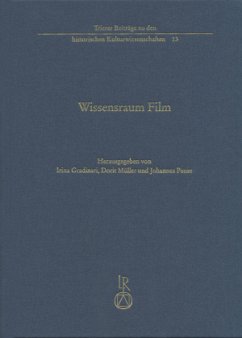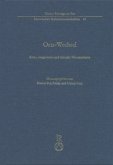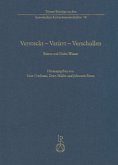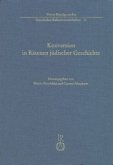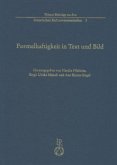In recent years, film studies do not only investigate epistemological conditions but rather spatial aspects of film. Some studies have analyzed the order of discourses in film, practices of generating knowledge or the self-reflective knowledge of the medium. Others focus on spatial dimensions of filmic representation. There was little effort made to bring together the aspects mentioned. With this in mind, the present volume aims to explore for the first time filmic knowledge production with regard to filmic space.
Our model "Wissensraum Film" ("Film as Knowledge Space") considers film as medium generating, disseminating, and transforming knowledge. At the same time, it is conscious of the fact that knowledge, as produced in film, is always already spatially composed. Film, thus, has to create spatial relationships, dynamics, and transformations to be able to develop its knowledge. The overarching question of the volume is concerned with the productivity of relational concepts of space in the investigation of knowledge generation: How does film create spatial structures and thus specific formations of knowledge? What is the relationship between individual epistemic elements? How do spatial conditions of screening influence filmic representation and how does self-reflective knowledge evolve in this process?
The volume investigates film as specific epistemic medium. Knowledge in film is not only confined to representing, interpreting, or transferring literary and scientific knowledge, just as the filmic space is not equal to Euclidean space in physics. Rather, there are multiple spatial and epistemic potentials exclusive to film in the different stages of its development. The contributions to this volume design models of describing this specific filmic mediality. They trace various genres, ouvres and aesthetics to determine their epistemic effects and correlate films with other types of media and non-filmic discourses.
Hinweis: Dieser Artikel kann nur an eine deutsche Lieferadresse ausgeliefert werden.
Our model "Wissensraum Film" ("Film as Knowledge Space") considers film as medium generating, disseminating, and transforming knowledge. At the same time, it is conscious of the fact that knowledge, as produced in film, is always already spatially composed. Film, thus, has to create spatial relationships, dynamics, and transformations to be able to develop its knowledge. The overarching question of the volume is concerned with the productivity of relational concepts of space in the investigation of knowledge generation: How does film create spatial structures and thus specific formations of knowledge? What is the relationship between individual epistemic elements? How do spatial conditions of screening influence filmic representation and how does self-reflective knowledge evolve in this process?
The volume investigates film as specific epistemic medium. Knowledge in film is not only confined to representing, interpreting, or transferring literary and scientific knowledge, just as the filmic space is not equal to Euclidean space in physics. Rather, there are multiple spatial and epistemic potentials exclusive to film in the different stages of its development. The contributions to this volume design models of describing this specific filmic mediality. They trace various genres, ouvres and aesthetics to determine their epistemic effects and correlate films with other types of media and non-filmic discourses.
Hinweis: Dieser Artikel kann nur an eine deutsche Lieferadresse ausgeliefert werden.
"Der Sammelband Wissensraum Film führt die Konzepte Raum, Wissen und Film nicht nur wissenshistorisch und medienwissenschaftlich zusammen. Vielmehr erkunden die Beiträge, wie Wissen durch seine spatiale Entfaltung im Film hervorgebracht wird. Der Band fragt somit nach der räumlichen Gebundenheit von Wissen und den genuin filmischen Modi der Wissensproduktion durch seine Verortungen. Angesichts der Engführung dreier solch großer Konzepte könnte befürchtet werden, dass die Befunde zu weit und damit entweder essentialistisch oder unergiebig ausfallen. Das Gegenteil ist der Fall: Die Triangulation von Raum, Wissen und Film erweist sich als methodische Lupe, welche das Wissen über die einzelnen Elemente nicht verwässert, sondern schärft. Hervorzuheben ist in diesem Sinne sowohl die durch die Herausgeber und Herausgeberinnen geleistete Bestimmung spatialer und epistemischer Möglichkeitsbedingungen und Potenziale des Films als auch der einführende Beitrag "Die epistemischen Motoren des Kinos" von Johannes Pause, welcher das dem Band zugrunde liegende WissensraumKonzept aufbereitet. Er unternimmt eine heuristische Differenzierung dreier Wissensebenen im Film, in die die Beiträge des Bandes verortet werden: zunächst Wissen, das vom Film aufgenommen und thematisiert wird (Wissen im Film), als nächstes Wissen, welches durch die filmische Technologie erst ermöglicht wird (Wissen durch Film), und zuletzt Wissen, welches der Film von sich selbst kreiert (Wissen über Film). Die Herausgeber und Herausgeberinnen ordnen die Beiträge nach den Möglichkeitsbedingungen der Wissensgenese und entwickeln dazu die drei Begriffe "Entfaltung", "Rahmung" und "Verschiebung."
Von Yumin Li
In: sehepunkte 16 (2016), Nr. 6.
-----------------------------------
"Angesichts der durchweg hohen Qualität der Beiträge ist den Herausgeberinnen mit Wissensraum Film ein bemerkenswertes Buch gelungen, das auf innovative Weise raumtheoretische Überlegungen und epistemologische Problemstellungen am Ort des Films zusammendenkt. Nicht zuletzt demonstriert es so, wie notwendig und anschlussfähig die Auseinandersetzung mit oft unhinterfragt bleibenden Grundprämissen der Medienwissenschaft - Wissensformen, Wissensformaten, Wissenskulturen - weiterhin bleibt."
In: Medien Wissenschaft 3/15, S. 387-389.
Von Yumin Li
In: sehepunkte 16 (2016), Nr. 6.
-----------------------------------
"Angesichts der durchweg hohen Qualität der Beiträge ist den Herausgeberinnen mit Wissensraum Film ein bemerkenswertes Buch gelungen, das auf innovative Weise raumtheoretische Überlegungen und epistemologische Problemstellungen am Ort des Films zusammendenkt. Nicht zuletzt demonstriert es so, wie notwendig und anschlussfähig die Auseinandersetzung mit oft unhinterfragt bleibenden Grundprämissen der Medienwissenschaft - Wissensformen, Wissensformaten, Wissenskulturen - weiterhin bleibt."
In: Medien Wissenschaft 3/15, S. 387-389.

